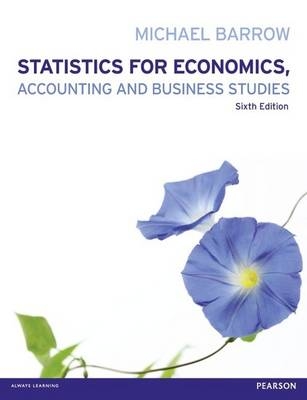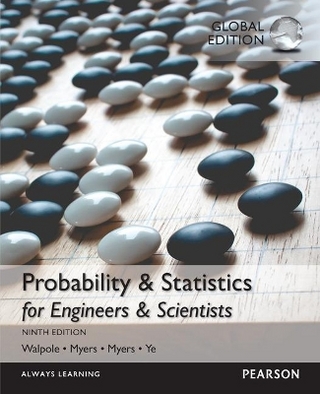
Statistics for Economics, Accounting and Business Studies with MyMathLab Global access card
Pearson Education Limited
978-0-273-78850-8 (ISBN)
- Titel erscheint in neuer Auflage
- Artikel merken
To access the eText and MyMathLab you need a course ID from your instructor.
Do you need to brush up on your statistical skills to truly excel in your economics or business course?
If you want to increase your confidence in statistics then this is the perfect book for you. The 6th edition of Statistics for Economics, Accounting and Business Studies continues to present a user-friendly and concise introduction to a variety of statistical tools and techniques. Throughout the text, the author demonstrates how and why these techniques can be used to solve real-life problems, highlighting common mistakes and assuming no prior knowledge of the subject.
MyLab and Mastering from Pearson improve results for students and educators. Used by over ten million students, they effectively engage learners at every stage.
With a proven 45% increase in pass rates, MyMathab Global has helped students make strides in learning for over 10 years. MyMathab Global has immersive content and tools that are so engaging that one student called it, "A perfect combination between pictures, videos and text. It's genius!" With MyMathab Global, students gain knowledge that they will use throughout their lives, and universities gain a partner deeply committed to helping students and educators achieve their goals.
For students
Personalised study plan: MyMathab Global gives you the opportunity to test yourself on key concepts and skills and generates a study plan based on topics you have not yet mastered. The study plan links to interactive exercises with guidance, to give you help when you need it most.
Pearson eText gives you access to an ebook that can be used on the go, and allows you to highlight, search and take notes as you read online. Access to the ebook depends on the package you have bought.
For educators
Online assignments, tests, quizzes can be easily created and assigned to students.
Gradebook: Assignments are automatically graded and visible at a glance.
For educator access, contact your Pearson Account Manager. To find out who your Account Manager is, visit www.pearsoned.co.uk/replocator
Guided tour of the book
Preface to the sixth edition
Publisher's acknowledgements
Introduction
1 Descriptive statistics
Introduction
Summarising data using graphical techniques
Looking at cross-section data: wealth in the UK in 2005
Summarising data using numerical techniques
The box and whiskers diagram
Time-series data: investment expenditures 1977-2009
Graphing bivariate data: the scatter diagram
Data transformations
The information and data explosion
Guidance to the student: how to measure your progress
Summary
Key terms and concepts
Reference
Problems
Answers to exercises
Appendix 1A: notation
Appendix 1B: E and V operators
Appendix 1C: Using logarithms
2 Probability theory and statistical inference
The definition of probability
Probability theory: the building blocks
Bayes' theorem
Decision analysis
Summary
Key terms and concepts
Problems
Answers to exercises
3 Probability distributions
Introduction
Random variables and probability distributions
The Binomial distribution
The Normal distribution
The sample mean as a Normally distributed variable
The relationship between the Binomial and Normal distributions
The Poisson distribution
Summary
Key terms and concepts
Problems
Answers to exercises
4 Estimation and confidence intervals
Introduction
Point and interval estimation
Rules and criteria for finding estimates
Estimation with large samples
Precisely what is a confidence interval?
Estimation with small samples: the t distribution
Summary
Key terms and concepts
Problems
Answers to exercises
Appendix: Derivations of sampling distributions
5 Hypothesis testing
Introduction
The concepts of hypothesis testing
The Prob-value approach
Significance, effect size and power
Further hypothesis tests
Hypothesis tests with small samples
Are the test procedures valid?
Hypothesis test and confidence intervals
Independent and dependent samples
Discussion of hypothesis testing
Summary
Key terms and concepts
Reference
Problems
Answers to exercises
6 The and F distributions
Introduction
The distribution
The F distibution
Analysis of variance
Summary
Key terms and concepts
Problems
Answers to exercises
Appendix: Use of and F distribution tables
7 Correlation and regression
Introduction
What determines the birth rate in developing countries?
Correlation
Regression analysis
Inference in the regression model
Some other issues in regression
Gapminder again
Summary
Key terms and concepts
References
Problems
Answers to exercises
8 Multiple regression
Introduction
Principles of multiple regression
What determines imports into the UK?
Finding the right model
Summary
Key terms and concepts
Reference
Problems
Answers to exercises
9 Data collection and sampling methods
Introduction
Using secondary data sources
Using electronic sources of data
Collecting primary data
The meaning of random sampling
Calculating the required sample size
Collecting the sample
Case study: the UK Living Costs and Food Survey
Summary
Key terms and concepts
References
Problems
10 Index numbers
Introduction
A simple index number
A price index with more than one commodity
Using expenditures as weights
Quantity and expenditure indices
The Retail Price Index
Inequality indices
The Lorenz curve
The Gini coefficient
Concentration ratios
Summary
Key terms and concepts
Reference
Problems
Answers to exercises
Appendix: Deriving the expenditure share form of the Laspeyres price index
11 Seasonal adjustment of time-series data
Introduction
The components of a time series
Forecasting
Further issues
Summary
Key terms and concepts
Problems
Answers to exercises
Important formulae used in this book
Appendix: Tables
Answers to problems
Index
| Erscheint lt. Verlag | 21.2.2013 |
|---|---|
| Verlagsort | Harlow |
| Sprache | englisch |
| Maße | 244 x 190 mm |
| Gewicht | 966 g |
| Themenwelt | Mathematik / Informatik ► Mathematik ► Statistik |
| Wirtschaft ► Volkswirtschaftslehre ► Ökonometrie | |
| ISBN-10 | 0-273-78850-7 / 0273788507 |
| ISBN-13 | 978-0-273-78850-8 / 9780273788508 |
| Zustand | Neuware |
| Haben Sie eine Frage zum Produkt? |
aus dem Bereich


